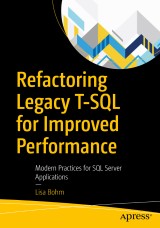Details

Refactoring Legacy T-SQL for Improved Performance
Modern Practices for SQL Server Applications|
56,99 € |
|
| Verlag: | Apress |
| Format: | |
| Veröffentl.: | 10.01.2020 |
| ISBN/EAN: | 9781484255810 |
| Sprache: | englisch |
Dieses eBook enthält ein Wasserzeichen.
Beschreibungen
Breathe new life into older applications by refactoring T-SQL queries and code using modern techniques. This book shows you how to significantly improve the performance of older applications by finding common anti-patterns in T-SQL code, then rewriting those anti-patterns using new functionality that is supported in current versions of SQL Server, including SQL Server 2019. The focus moves through the different types of database objects and the code used to create them, discussing the limitations and anti-patterns commonly found for each object type in your database.<div><br></div><div>Legacy code isn’t just found in queries and external applications. It’s also found in the definitions of underlying database objects such as views and tables. This book helps you quickly find problematic code throughout the database and points out where and how modern solutions can replace older code, thereby making your legacy applications run faster and extending their lifetimes. Author Lisa Bohm explains the logic behind each anti-pattern, helping you understand why each pattern is a problem and showing how it can be avoided. Good coding habits are discussed, including guidance on topics such as readability and maintainability. </div><div><br></div><div><br></div><div><b>What You Will Learn</b></div><div><div><ul><li>Find specific areas in code to target for performance gains</li><li>Identify pain points quickly and understand why they are problematic</li><li>Rewrite legacy T-SQL to reduce or eliminate hidden performance issues</li><li>Write modern code with an awareness of readability and maintainability</li><li>Recognize and correlate T-SQL anti-patterns with techniques for better solutions</li><li>Make a positive impact on application user experience in your organization</li></ul></div></div><div><br></div><div><b>Who This Book Is For</b></div><div><br></div><div>Database administrators or developers who maintain older code, those frustrated with complaints about slow codewhen there is so much of it to fix, and those who want a head start in making a positive impact on application user experience in their organization<br></div><div><br></div>
<b>Part I. Everything Is Slow.-</b>1. T-SQL Triage.-2. Documentation.-.-<b>Part II. Database Structure.-</b>3. Database Tables.-4. Database Views.-.-<b>Part III. CRUD Objects.-</b>5. Triggers.-6. Stored Procedures.-7. Functions.-.-<b>Part IV. The Bad and The Ugly.-</b>8. Agent Jobs.-9. External Influences.
<b>Lisa Bohm</b> leads a team of database administrators for a software development company. Her history with legacy database code began early in her career with a summer project to rewrite the chemical inventory database for the research division of a local VA hospital. From there, she went on to building front-end web applications. When the web calls timed out, Lisa dug in to learn what databases can do. She has since transitioned into database administration, inheriting and improving legacy applications along the way. Her personal focus remains on solid database architecture and writing well-performing T-SQL. <div><br></div>
Breathe new life into older applications by refactoring T-SQL queries and code using modern techniques. This book shows you how to significantly improve the performance of older applications by finding common anti-patterns in T-SQL code, then rewriting those anti-patterns using new functionality that is supported in current versions of SQL Server, including SQL Server 2019. The focus moves through the different types of database objects and the code used to create them, discussing the limitations and anti-patterns commonly found for each object type in your database.<div><br></div><div>Legacy code isn’t just found in queries and external applications. It’s also found in the definitions of underlying database objects such as views and tables. This book helps you quickly find problematic code throughout the database and points out where and how modern solutions can replace older code, thereby making your legacy applications run faster and extending their lifetimes. Author Lisa Bohm explains the logic behind each anti-pattern, helping you understand why each pattern is a problem and showing how it can be avoided. Good coding habits are discussed, including guidance on topics such as readability and maintainability. </div><div><br></div><div>You will:<br></div><div><ul><li>Find specific areas in code to target for performance gains</li><li>Identify pain points quickly and understand why they are problematic</li><li>Rewrite legacy T-SQL to reduce or eliminate hidden performance issues</li><li>Write modern code with an awareness of readability and maintainability</li><li>Recognize and correlate T-SQL anti-patterns with techniques for better solutions</li><li>Make a positive impact on application user experience in your organization</li></ul></div><div><br></div>
Helps to mitigate technical debt found in legacy code Shows how to target performance pain points commonly found in older code Promotes awareness of modern coding techniques yielding strong performance

















